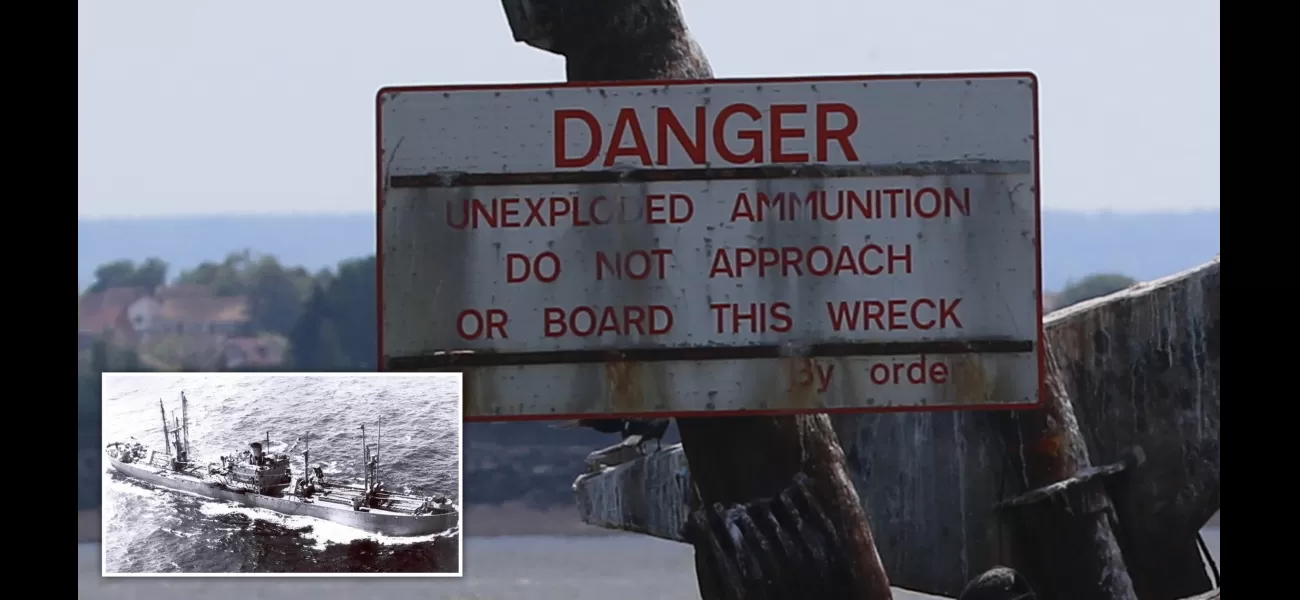A sunken ship filled with explosives has the potential to cause a devastating tidal wave in the Thames.
New study finds that the WWII boat is deteriorating more quickly than previously believed.
July 27th 2024.

According to a recent survey, the SS Richard Montgomery, a sunken ship in the Thames Estuary, is deteriorating at an alarming rate. This ship, also known as the 'Doomsday Wreck', has been underwater for 78 years and is now severely corroded. The main concern is the 1,400 tonnes of unexploded bombs still onboard, which could potentially trigger a 'catastrophic' blast if the ship's three masts collapse onto them. This has prompted the Department for Transport to bring forward their plans to remove the masts in order to ensure the safety of the public.
The department stated that their main priority is to protect the public and reduce the risk posed by the SS Richard Montgomery. They have conducted a thorough survey and based on their findings, they have revised their initial timeframe for removing the masts. Their goal is to remove them as soon as possible, as long as they can establish a safe and effective way to do so.
Unfortunately, the statement did not specify a timeline for the removal. The latest survey, conducted in 2023, revealed some concerning developments. The report noted that the deck near hold three has started to collapse on the port side, and the forward section of the wreck has increased its lean by 10 to 15cm. This growing lean could potentially undercut the wreckage as the supporting sediment erodes away. Additionally, there is a crack along the second cargo hold that has widened and lengthened significantly in just one year.
The survey also mentioned that the US Liberty Ship is carrying 7,000 tonnes of explosives, and around 1,400 of those are still onboard. The back of the ship is also showing signs of deterioration, with a six-meter section of the deck collapsing over half a meter in just one year. This has raised concerns for Rich Lehmann, who chairs the environment committee at Swale Borough Council, which covers Sheerness. He stated that the council is closely monitoring the situation and is in communication with the Department for Transport and other relevant agencies to ensure necessary precautions are in place.
The potential consequences of the bombs exploding are dire. A previous report from Medway Council suggested that it could trigger a massive tsunami that would cause widespread destruction and put many lives at risk. Researchers from Defence Research and Development Canada also warned that the explosion could be one of the world's biggest non-nuclear explosions, causing devastation and loss of life.
This alarming situation has prompted Southend Labour councillor Lydia Hyde to urge for immediate action. She stated that the condition of the masts has degraded to a point where it is crucial to act as soon as possible. The potential impact of the explosion is not limited to one area, as it could severely affect multiple areas if the bombs detonate. The safety of the community and the protection of the marine environment remain top priorities for the council.
The SS Richard Montgomery, a ship that has been underwater for 78 years, is quickly deteriorating according to a recent survey. This ship is known as the 'Doomsday Wreck' and sank during World War II near Sheerness in Kent and Southend-on-Sea in Essex in 1944. The ship is carrying 1,400 tonnes of unexploded bombs and there are concerns that the corroded ship's three masts could collapse and set off a catastrophic explosion. The Department for Transport, who manages the ship, had already planned to remove the masts but after new survey results showed a faster rate of deterioration, the timetable for removal has been sped up.
In a statement, the Department for Transport stated that their main priority is to ensure the safety of the public and reduce any risk posed by the SS Richard Montgomery. They have conducted crucial surveys of the wreckage and based on their findings, they are revising their initial timeline for removing the masts in the safest manner possible. Their goal is to remove the masts as soon as possible, as long as a safe and effective operational method can be established.
However, the statement did not specify how soon the masts could be removed. The new survey, which was released last week and conducted in 2023, revealed some concerning findings. The report warned that the deck space near hold three has started to collapse and the forward section of the wreck has an increased lean of 10 to 15cm. This lean could potentially cause the wreckage to be undercut as the supporting sediment erodes away.
The survey also noted a crack along the second cargo hold that has grown wider and longer in the span of a year, causing the forward part of the wreck to appear as though it is splitting in two. This has also caused the deck above to collapse up to 20cm in one year. The ship, which was carrying 7,000 tonnes of explosives, still has around 1,400 tonnes onboard. The back of the ship is also showing signs of deterioration, potentially breaking in two about halfway along its length.
Rich Lehmann, who chairs the environment committee at Swale Borough Council, expressed concern about the ship's deterioration and stated that the council is closely monitoring the situation. They are in communication with the Department for Transport and other relevant agencies to ensure that all necessary precautions are taken to mitigate any potential risks. The safety of the community and the protection of the marine environment are their top priorities.
The potential consequences of an explosion are dire. According to a report from Medway Council, the blast could trigger a massive tsunami that could devastate everything in its path. It is estimated that the explosion could hurl a 1,000ft wide column of water, mud, metal, and munitions almost 10,000ft into the air, posing a threat to wildlife and lives. Researchers at Defence Research and Development Canada also warned in 2022 that the Montgomery could potentially cause one of the world's biggest non-nuclear explosions, resulting in widespread destruction and death.
Earlier this year, Southend Labour councillor Lydia Hyde stated that the situation has deteriorated to the point where action must be taken as soon as possible. The Montgomery's payload exploding could severely affect a number of areas and it is crucial to remove the masts before any potential disaster occurs.
The department stated that their main priority is to protect the public and reduce the risk posed by the SS Richard Montgomery. They have conducted a thorough survey and based on their findings, they have revised their initial timeframe for removing the masts. Their goal is to remove them as soon as possible, as long as they can establish a safe and effective way to do so.
Unfortunately, the statement did not specify a timeline for the removal. The latest survey, conducted in 2023, revealed some concerning developments. The report noted that the deck near hold three has started to collapse on the port side, and the forward section of the wreck has increased its lean by 10 to 15cm. This growing lean could potentially undercut the wreckage as the supporting sediment erodes away. Additionally, there is a crack along the second cargo hold that has widened and lengthened significantly in just one year.
The survey also mentioned that the US Liberty Ship is carrying 7,000 tonnes of explosives, and around 1,400 of those are still onboard. The back of the ship is also showing signs of deterioration, with a six-meter section of the deck collapsing over half a meter in just one year. This has raised concerns for Rich Lehmann, who chairs the environment committee at Swale Borough Council, which covers Sheerness. He stated that the council is closely monitoring the situation and is in communication with the Department for Transport and other relevant agencies to ensure necessary precautions are in place.
The potential consequences of the bombs exploding are dire. A previous report from Medway Council suggested that it could trigger a massive tsunami that would cause widespread destruction and put many lives at risk. Researchers from Defence Research and Development Canada also warned that the explosion could be one of the world's biggest non-nuclear explosions, causing devastation and loss of life.
This alarming situation has prompted Southend Labour councillor Lydia Hyde to urge for immediate action. She stated that the condition of the masts has degraded to a point where it is crucial to act as soon as possible. The potential impact of the explosion is not limited to one area, as it could severely affect multiple areas if the bombs detonate. The safety of the community and the protection of the marine environment remain top priorities for the council.
The SS Richard Montgomery, a ship that has been underwater for 78 years, is quickly deteriorating according to a recent survey. This ship is known as the 'Doomsday Wreck' and sank during World War II near Sheerness in Kent and Southend-on-Sea in Essex in 1944. The ship is carrying 1,400 tonnes of unexploded bombs and there are concerns that the corroded ship's three masts could collapse and set off a catastrophic explosion. The Department for Transport, who manages the ship, had already planned to remove the masts but after new survey results showed a faster rate of deterioration, the timetable for removal has been sped up.
In a statement, the Department for Transport stated that their main priority is to ensure the safety of the public and reduce any risk posed by the SS Richard Montgomery. They have conducted crucial surveys of the wreckage and based on their findings, they are revising their initial timeline for removing the masts in the safest manner possible. Their goal is to remove the masts as soon as possible, as long as a safe and effective operational method can be established.
However, the statement did not specify how soon the masts could be removed. The new survey, which was released last week and conducted in 2023, revealed some concerning findings. The report warned that the deck space near hold three has started to collapse and the forward section of the wreck has an increased lean of 10 to 15cm. This lean could potentially cause the wreckage to be undercut as the supporting sediment erodes away.
The survey also noted a crack along the second cargo hold that has grown wider and longer in the span of a year, causing the forward part of the wreck to appear as though it is splitting in two. This has also caused the deck above to collapse up to 20cm in one year. The ship, which was carrying 7,000 tonnes of explosives, still has around 1,400 tonnes onboard. The back of the ship is also showing signs of deterioration, potentially breaking in two about halfway along its length.
Rich Lehmann, who chairs the environment committee at Swale Borough Council, expressed concern about the ship's deterioration and stated that the council is closely monitoring the situation. They are in communication with the Department for Transport and other relevant agencies to ensure that all necessary precautions are taken to mitigate any potential risks. The safety of the community and the protection of the marine environment are their top priorities.
The potential consequences of an explosion are dire. According to a report from Medway Council, the blast could trigger a massive tsunami that could devastate everything in its path. It is estimated that the explosion could hurl a 1,000ft wide column of water, mud, metal, and munitions almost 10,000ft into the air, posing a threat to wildlife and lives. Researchers at Defence Research and Development Canada also warned in 2022 that the Montgomery could potentially cause one of the world's biggest non-nuclear explosions, resulting in widespread destruction and death.
Earlier this year, Southend Labour councillor Lydia Hyde stated that the situation has deteriorated to the point where action must be taken as soon as possible. The Montgomery's payload exploding could severely affect a number of areas and it is crucial to remove the masts before any potential disaster occurs.
[This article has been trending online recently and has been generated with AI. Your feed is customized.]
[Generative AI is experimental.]
0
0
Submit Comment





